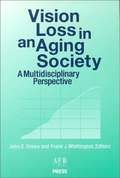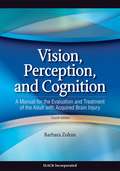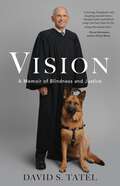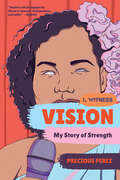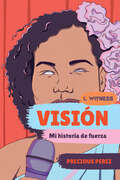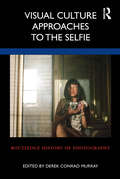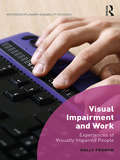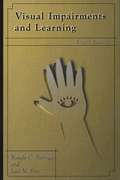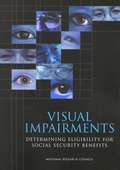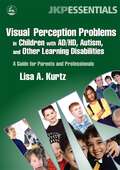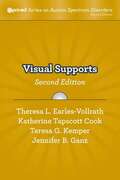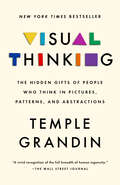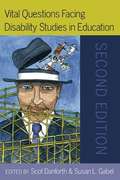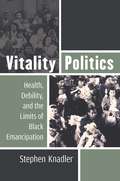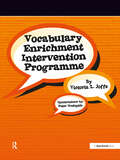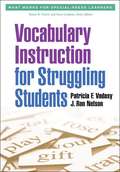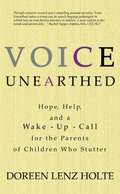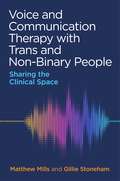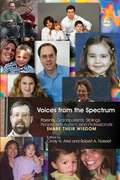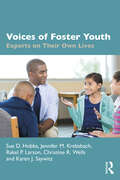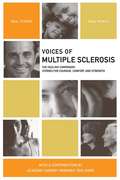- Table View
- List View
Vision Loss in an Aging Society: A Multidisciplinary Perspective
by John E. Crews Frank J. WhittingtonThis book makes an important contribution to our understanding of the many facets of experience facing those with eye problems. It does so through a multidisciplinary examination of the elements of professional practice, research, policy, and intervention related to vision loss and vision rehabilitation.
Vision and Aging: Crossroads for Service Delivery
by Alberta L. OrrVision and Aging: Crossroads for Service Delivery focuses on the impact of visual impairment on older persons and their families. It also discusses the extent of that impact when services in the aging and blindness fields theoretically designed to enable older visually impaired persons to function independently are not available or accessible.
Vision, Perception, and Cognition: A Manual for the Evaluation and Treatment of the Adult with Acquired Brain Injury
by Barbara ZoltanVision Perception and Cognition, Fourth Edition is a concisely structured text that expertly addresses clinical reasoning and decision making for the entire evaluation and treatment process of the adult with acquired brain injury. Provided are theoretical information, guidelines for both static and dynamic assessment, information on specific standardized evaluations, guidelines for adaptive and restorative treatment based on described theoretical and evidence-based information, and information on environmental impact of client performance.
Vision: A Memoir of Blindness and Justice
by David S. TatelThe "moving, thoughtful, and inspiring memoir" (Bryan Stevenson, author of Just Mercy) by one of America&’s most accomplished public servants and legal thinkers—who spent years denying and working around his blindness, before finally embracing it as an essential part of his identity. David Tatel has served nearly 30 years on America&’s second highest court, the United States Court of Appeals for the D.C. Circuit, where many of our most crucial cases are resolved—or teed up for the Supreme Court. He has championed equal justice for his entire adult life; decided landmark environmental and voting cases; and embodied the ideal of what a great judge should be. Yet he has been blind for the past 50 of his 80-plus years. Initially, he depended upon aides to read texts to him, and more recently, a suite of hi-tech solutions has allowed him to listen to reams of documents at high speeds. At first, he tried to hide his deteriorating vision, and for years, he denied that it had any impact on his career. Only recently, partly thanks to his first-ever guide dog, Vixen, has he come to fully accept his blindness and the role it's played in his personal and professional lives. His story of fighting for justice over many decades, with and without eyesight, is an inspiration to us all.
Vision: My Story Of Strength (I, Witness #0)
by Precious PerezA young activist opens a window into her journey to become a professional musician and leader for the disabled community. Ever since Precious Perez was a child, she has loved to sing. Born and raised outside Boston, her family joked that she’d eventually study at Berklee College of Music. But when a high school music teacher advocated for Precious’s talent, her dream became a reality. Precious was born two-and-a-half months premature and weighed just one pound. Her eyes did not develop fully, and she is blind. Growing up, most people focused on what Precious could not do because of her disability. With her teacher’s support, Precious realized all the things she could do with her disability—starting with attending Berklee. With a voice that is both accessible and engaging, Vision brings forward an empowering first-person account of a woman finding strength and purpose in her disability. The I, Witness series delivers compelling narrative nonfiction by young people, for young people.
Visión (Vision Spanish Language Edition): Mi historia de fuerza
by Precious PerezIn this Spanish-language edition of Vision, a young blind activist shares how she became a leader for the disabled community. Ever since Precious Perez was a child, she has loved to sing. Her family always praised her singing, saying she could even attend Berklee College of Music one day—planting a seed that would become her dream. Precious was born two-and-a-half months premature and weighed just one pound. Her eyes did not develop fully, and she is blind. Growing up, most people focused on what Precious could not do because of her disability. With her teacher’s support, Precious realized all the things she could do with her disability—starting with attending Berklee. This Spanish-language edition of Precious’s compelling first-person narrative brings forward an empowering first-person account of a woman finding strength and purpose in her disability to a wider audience. “[A] triumphant story of a young person’s success.”—School Library Journal “Readers will be engaged by [Perez’s] honesty, tenaciousness, and belief.”—Booklist
Visual Culture Approaches to the Selfie (Routledge History of Photography)
by Derek Conrad MurrayThis collection explores the cultural fascination with social media forms of self-portraiture, "selfies," with a specific interest in online self-imaging strategies in a Western context. This book examines the selfie as a social and technological phenomenon but also engages with digital self-portraiture as representation: as work that is committed to rigorous object-based analysis. The scholars in this volume consider the topic of online self-portraiture—both its social function as a technology-driven form of visual communication, as well as its thematic, intellectual, historical, and aesthetic intersections with the history of art and visual culture. This book will be of interest to scholars of photography, art history, and media studies.
Visual Impairment and Work: Experiences of Visually Impaired People (Interdisciplinary Disability Studies)
by Sally FrenchThis book traces the development of paid work for visually impaired people in the UK from the 18th century to the present day. It gives a voice to visually impaired people to talk about their working lives and documents the history of employment from their experience, an approach which is severely lacking in the current literature about visual impairment and employment. By analysing fifty in-depth face-to-face interviews with visually impaired people talking about their working lives (featuring those who have worked in traditional jobs such as telephony, physiotherapy and piano tuning, to those who have pursued more unusual occupations and professions), and grouping them according to occupation and framed by documentary, historical research, these stories can be situated in their broader political, economic, ideological and cultural contexts. The themes that emerge will help to inform present day policy and practice within a context of high unemployment amongst visually impaired people of working age. It is part of a growing literature which gives voice to disabled people about their own lives and which adds to the growing academic discipline of disability studies and the empowerment of disabled people.
Visual Impairment: An Overview
by Ian L. Bailey Amanda HallA general, down-to-earth look at the common forms of vision loss and their impact on the individual. Explains the different aspects of visual impairment, describes adaptive techniques and devices, and provides information on available resources and services in a concise and easy-to-understand manner for busy professionals and visually impaired people and their families. Visual Impairment: An Overview seeks to clarify misconceptions and misunderstandings of the different aspects of visual impairment, describe adaptive techniques and devices, and provide information on available resources and services. Anyone with questions about vision loss will find this book a useful resource designed to increase understanding of visual impairment and the ability of visually impaired people to lead unimpaired lives.
Visual Impairments and Learning
by Jane N. Erin Natalie C. BarragaNew ways of thinking about individuals with visual impairments are presented and developmental and learning processes are described, for students in education and for regular and special education teachers, clinical and educational vision specialists, parents, and support personnel. Coverage also includes terminology, concerns of the earliest years of life, educational settings, assessment, curriculum, and specialized educational materials. This fourth edition reflects the latest research on how children with visual and additional disabilities learn, offers new ways of looking at curricula for children with visual disabilities, and considers new legislative requirements. Annotation c. Book News, Inc. , Portland, OR (booknews. com)
Visual Impairments: Determining Eligibility For Social Security Benefits
by Committee on Disability Determination for Individuals Visual ImpairmentsWhen children and adults apply for disability benefits and claim that a visual impairment has limited their ability to function, the U.S. Social Security Administration (SSA) is required to determine their eligibility. To ensure that these determinations are made fairly and consistently, SSA has developed criteria for eligibility and a process for assessing each claimant against the criteria. Visual Impairments: Determining Eligibility for Social Security Benefits examines SSA's methods of determining disability for people with visual impairments, recommends changes that could be made now to improve the process and the outcomes, and identifies research needed to develop improved methods for the future. The report assesses tests of visual function, including visual acuity and visual fields whether visual impairments could be measured directly through visual task performance or other means of assessing disability. These other means include job analysis databases, which include information on the importance of vision to job tasks or skills, and measures of health-related quality of life, which take a person-centered approach to assessing visual function testing of infants and children, which differs in important ways from standard adult tests.
Visual Perception Problems in Children with AD/HD, Autism, and Other Learning Disabilities: A Guide for Parents and Professionals
by Lisa A. KurtzThis book provides a comprehensive overview of vision problems in children with developmental disabilities such as AD/HD, autism spectrum disorders, and specific learning disabilities. Written in a very accessible style, it is appropriate for parents and professionals alike and offers non-technical explanations of how vision difficulties are screened for and advice on where to seek appropriate professional care. Lisa Kurtz outlines a range of activities for strengthening children's functional vision and perceptual skills using simple, homemade materials that are readily available in the home or classroom. This is an excellent practical companion for parents of children with visual perception problems and the professionals who work with them.
Visual Supports
by Theresa L. Earles-VollrathVisual supports are essential components of programs serving students with autism spectrum disorders (ASD) and can help provide a variety of information that enables these students to better understand and complete tasks with greater independence. Visual Supports, Second Edition provides information to help educators and families utilize visual displays or cues, such as schedules, boundaries, labels, and consequence maps, to help students with ASD achieve improved learning outcomes. Contents 1. Creating Visual Supports for Students With Autism Spectrum Disorders 2. Visual Supports That Provide Information 3. Visual Strategies That Support Behavior and Emotional Regulation 4. Visual Supports That Structure the Learning Environment 5. Visual Supports That Enhance Cognition and Language Development 6. Visual Supports That Enhance Comprehension of Classroom Instruction 7. Visual Strategies That Support Conversation and Social Skills
Visual Thinking: The Hidden Gifts of People Who Think in Pictures, Patterns, and Abstractions
by Temple GrandinINSTANT NEW YORK TIMES BESTSELLERWINNER OF THE NAUTILUS GOLD AWARD&“A powerful and provocative testament to the diverse coalition of minds we&’ll need to face the mounting challenges of the twenty-first century.&” —Steve Silberman &“An absolute eye-opener.&” —Frans de WaalA landmark book that reveals, celebrates, and advocates for the special minds and contributions of visual thinkersA quarter of a century after her memoir, Thinking in Pictures, forever changed how the world understood autism, Temple Grandin— &“an anthropologist on Mars,&” as Oliver Sacks dubbed her—transforms our awareness of the different ways our brains are wired. Do you have a keen sense of direction, a love of puzzles, the ability to assemble furniture without crying? You are likely a visual thinker. With her genius for demystifying science, Grandin draws on cutting-edge research to take us inside visual thinking. Visual thinkers constitute a far greater proportion of the population than previously believed, she reveals, and a more varied one, from the photo-realistic &“object visualizers&” like Grandin herself, with their intuitive knack for design and problem solving, to the abstract, mathematically inclined &“visual spatial&” thinkers who excel in pattern recognition and systemic thinking. She also makes us understand how a world increasingly geared to the verbal tends to sideline visual thinkers, screening them out at school and passing over them in the workplace. Rather than continuing to waste their singular gifts, driving a collective loss in productivity and innovation, Grandin proposes new approaches to educating, parenting, employing, and collaborating with visual thinkers. In a highly competitive world, this important book helps us see, we need every mind on board.
Visually Impaired Seniors as Senior Companions: A Reference Guide for Program Development
by Alberta L. OrrThe guide provides a framework for the reader to understand the core issues related to aging and vision loss, as well as the needs and capabilities of older visually impaired persons.
Vital Questions Facing Disability Studies in Education
by Susan L. Gabel; Scot DanforthVital Questions Facing Disability Studies in Education provides an overview and introduction to the growing field of disability studies in education, including the application of the interdisciplinary field of disability studies to inclusive education, teacher education, educational research, and educational policy development.
Vitality Politics: Health, Debility, and the Limits of Black Emancipation (Corporealities: Discourses Of Disability)
by Stephen KnadlerVitality Politics focuses on a slow racial violence against African Americans through everyday, accumulative, contagious, and toxic attritions on health. The book engages with recent critical disability studies scholarship to recognize that debility, or the targeted maiming and distressing of Black populations, is a largely unacknowledged strategy of the U.S. liberal multicultural capitalist state. This politicization of biological health serves as an instrument for insisting on a racial state of exception in which African Americans’ own unhealthy habits and disease susceptibility justifies their legitimate suspension from full rights to social justice, economic opportunity, and political freedom and equality. The book brings together disability studies, Black Studies, and African American literary history as it highlights the urgent need and gives weight to a biopolitics of debilitation and medicalization to better understand how Black lives are made not to matter in our supposedly race-neutral multicultural democracy.
Vocabulary Enrichment Programme: Enhancing the Learning of Vocabulary in Children
by Victoria JoffeThis book helps to enhance the understanding and use of vocabulary in secondary school students and young adults. Specifically designed for older children and young adults with language and communication needs, this practical language programme was created by a specialist speech & language therapist with input from secondary school teachers and students. The Vocabulary Enrichments Programme: focuses on enhancing the understanding and expression of vocabulary and word meanings in students aged from 8 to 18 aims to create an awareness of how improved vocabulary knowledge can be used to enhance learning in school and social interactions in school and home environments encourages an awareness and interest in words and language, introduces the concept of words and meanings and identifies their role and use in language, communication and social interaction introduces the word map and explore the rich networks of information attached to each word, including the meanings and make up of words using root and base words, suffixes and prefixes, synonyms and antonyms, and the etymology (origins) of words focuses on themes taken from the National Curriculum, including living and non living organisms, planet Earth and the world, the human body, emotions, healthy living, and occupations enhances the understanding and use of figurative and idiomatic language as well as more compound and complex sentence structures introduces a range of cueing techniques to aid in word retrieval. This book provide effective strategies for word learning to encourage independent word learning skills. It teaches an effective, efficient and realistic use of the dictionary as a tool for word learning and explore the role of the thesaurus in enhancing oral and written work.
Vocabulary Instruction for Struggling Students
by Patricia F. Vadasy Patricia NelsonAddressing a key skill in reading, writing, and speaking, this comprehensive book is grounded in cutting-edge research on vocabulary development. It presents evidence-based instructional approaches for at-risk students, including English language learners and those with learning difficulties. Coverage ranges from storybook reading interventions for preschoolers to direct instruction and independent word-learning strategies for older students. Guidance is provided on using word lists effectively and understanding how word features influence learning. The book also reviews available vocabulary assessment tools and describes how to implement them in a response-to-intervention framework.
Voice Unearthed: Hope, Help and a Wake-up Call for the Parents of Children Who Stutter
by Doreen Lenz HolteThe primary message young children get in stuttering therapy is that they can and should manage their speech - in other words, try to not stutter - by utilizing speech tools and techniques. Is it possible that the anxiety this causes can create an even greater burden? Can that burden lead to excessive silence and disengagement - a far greater handicap than the stuttering itself? <P><P> Through personal narrative and extensive research, Voice Unearthed answers these questions with a resounding “yes!” It also includes practical guidance that helps keep children talking while minimizing everyone’s anxiety around communicating. <P><P> Voice Unearthed frees us from the pointless, painful chore of counting speech errors and reminds us to keep our eyes on what truly matters. It’s also a wake-up call for parents, professionals, and the entire field of speech therapy – and a reminder to “first do no harm.”
Voice and Communication Therapy with Trans and Non-Binary People: Sharing the Clinical Space
by Gillie Stoneham Matthew MillsSpecifically aimed at Speech and Language Therapists (SLTs) and voice practitioners, this book follows up from the authors' first book, The Voice Book for Trans and Non-Binary People. It sets out cultural competence, psychological and vocal skills, group activities and improvisations frameworks and exercises to helps SLTs develop their skills for working with trans and non-binary clients, including facilitation and coaching, emotional intelligence, role-play and solution-focused therapy, narrative therapy practices. It also includes many contributions from the trans community and a range of clinical professionals to emphasise the collaborative space.Written by two leading authorities on voice and communication therapy for trans people, this is an essential and authoritative resource for anyone working with trans and non-binary clients who are seeking their voice exploration.
Voice for the Mad: The Life of Dorothea Dix
by David GollaherThis is a comprehensive biography of a nearly forgotten social reformer of the 19th century. After her own experience with depression and recovery, Dorothea Dix became a passionate champion of the "moral treatment" popular in Europe. In her native Massachusetts she documented the horrific treatment that was the lot of most people with mental illness, and petitioned the legislature to establish asylums that would provide loving care. Dix took her crusade across the country, and for a time her work transformed psychiatric care. Gollaher describes Dix's public persona and delves into her often troubled private life as well.
Voices from the Spectrum: Parents, Grandparents, Siblings, People with Autism, and Professionals Share Their Wisdom
by Cindy N. Ariel Robert A. NaseefAuthor of Could It Be Autism? A Parent's Guide to the First Signs and Next Steps Voices from the Spectrum is a compelling collection of personal accounts from people on the autism spectrum and those who care for them, including professionals, friends and family members. The essays in this collection tell of both the positive and negative effects of autism on individuals and families, and pose the question: is a diagnosis on the autism spectrum a puzzle to be solved, or something to be embraced and accepted? The broad scope of this book presents insights into the autism spectrum from many different perspectives - from first-hand accounts of the autistic child's school and childhood experiences to parents' and grandparents' reactions to a diagnosis. A number of chapters written by professionals explain their motivations for working with autistic people and reveal what they have learned from their work and how it has affected their lives. The contributors describe experiences of autism from the mildest to the most severe case, and share their methods of adapting to life on the spectrum. Voices from the Spectrum will appeal to a wide readership of adults and younger people on the autism spectrum, their families and friends, as well as practitioners.
Voices of Foster Youth: Experts on Their Own Lives
by Karen J. Saywitz Sue D. Hobbs Jennifer M. Krebsbach Rakel P. Larson Christine R. WellsThis important book offers unique insight into the experience of foster youth from 27 countries around the world. It provides a systematic review of literature reporting the experiences of youth in care, addressing a wide range of key topics in this multidisciplinary field, and presenting the views and perceptions of these young people.Including a meta-analysis on contact with birth parents, it examines youth’s experiences of the foster care system; contact and relationships; caregiving and relationships with caregivers; placements; and emotional well-being. These five core themes embrace a wide range of crucial topics including foster youth’s involvement in decisions about themselves; interactions with social workers, birth families, foster families, peers, and friends; the benefits and challenges of foster care; the stigma attached to being in care; mental health, well-being, and belonging; and developing a sense of self.This essential volume is for students and scholars of child and adolescent development, social work, education, sociology, and public health. Illustrated with quotes from former and current foster youth, and with research-based recommendations for best practices in foster care, it is also for professional social workers, psychologists, child advocates, children’s therapists, children’s attorneys, youth workers, and foster parents.
Voices of Multiple Sclerosis: Stories for Courage, Comfort and Strength
by Richard Day GoreOffering candid, heartfelt, and inspiring stories of 40 diverse individuals who have been affected by multiple sclerosis (MS), this compilation creates a connection that is vital to those dealing with the mysterious and difficult symptoms of this nerve condition. With 10,000 new cases diagnosed in the United States each year and its causes still not fully understood, these stories of personal experience act as a support group by offering advice and encouragement and creating a sense of community. The collection also features current medical information by noted experts in the fields of MS research and treatment. The resource section is packed with organizations offering hope and help for those with MS and their families and friends.
